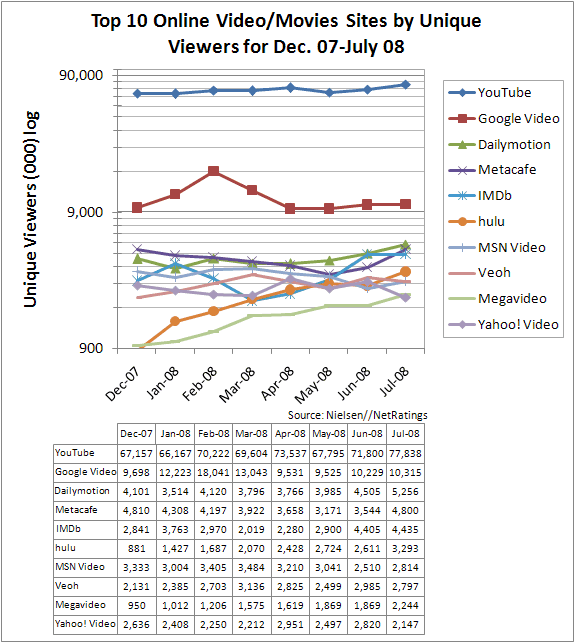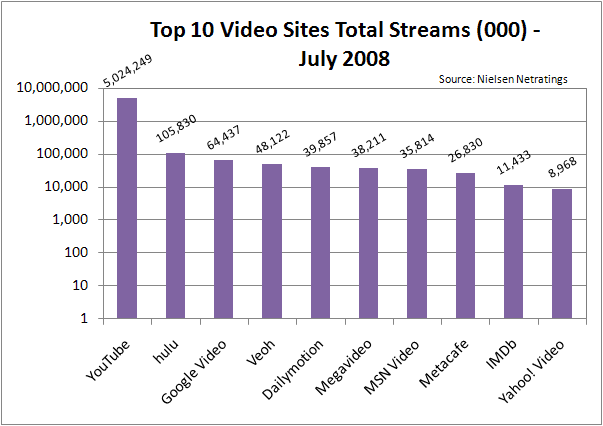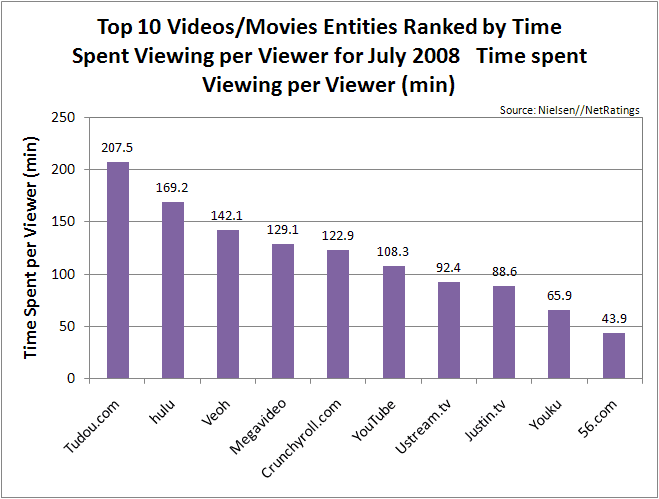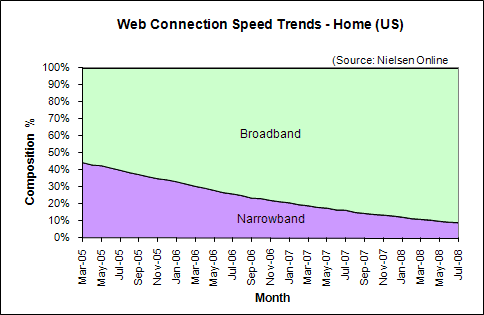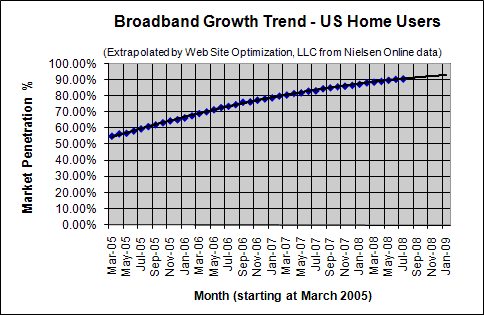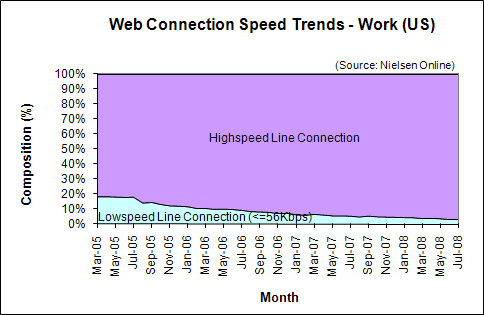YouTube continues to dominate the top video sites tracked by Nielsen Online. Updating last year’s top 10 video site survey this year we find YouTube even further ahead of its nearest “competitor,” Google. As of July 2008, YouTube had more than 7.5 times more unique viewers than Google Video. Combined together, Google properties YouTube and Google Video have over 88 million unique viewers, and make up over 36% of the share of videos viewed on the Internet. A recent study by the Communications Workers of America revealed that the US ranks 15th worldwide in broadband speed. In other news, US broadband penetration crept up 0.27 percentage points to 90.76% in July 2008.
Top 10 Video Sites by Unique Viewers
YouTube continues to dominate the top 10 video sites with more than 77 million unique viewers (77,838,000 users) in July 2008 (see Figure 1). From January 2008 to July 2008 YouTube viewership grew by 17.6%, while Google Video fell by 15.6% from 12,223,000 to 10,315,000 unique viewers. Combining Google Video with YouTube more than 88,153,000 unique viewers watched videos at Google-owned sites, comprising more than 36 percent of all videos viewed. Hulu showed the strongest growth over the last seven months, growing by 2.7 times from 881,000 to 3,293,000 users. Megavideo grew by 2.4 times from 950,000 to 2,244,000 users while Yahoo! Video actually dropped by 18.5% from 2,636,000 to 2,147,000 unique viewers. Note that AOL Video was not included in this report, but should be near Google Video in viewership (see Nielsen Online Reports Topline U.S. Data For July 2008 of August 12, 2008 for general AOL statistics).
Figure 1: Top 10 Video/Movie Sites by Unique Viewers for Dec. 2007 to July 2008
Source: Nielsen Online
Top 10 Video Sites by Total Videos Streamed
In terms of the number of videos viewed, Figure 2 shows the top 10 video sites by the number of streams. YouTube comes out on top with over 5 billion streams in July 2008, followed by Hulu with 105,830,000, Google Video at 64,437,000, Veoh at 48,122,000, and Dailymotion at 39,857,000 streams. Note that Figure 1 and 2 are plotted on log Y axes, due to the large disparity between the top 10 video sites.
Figure 2: Top 10 Video Sites by Total Streams July 2008
Source: Nielsen Online
Top 10 Video Sites by Time Spent
In terms of stickiness Tudou.com leads all video sites at 207.5 minutes spent viewing per viewer in July 2008. Followed by hulu.com at 169.2 minutes, Veoh at 142.1 minutes, Megavideo at 129.1 minutes, and Crunchyroll.com at 122.9 minutes.
Figure 3: Top 10 Video Sites by Time Spent by User for July 2008
Source: Nielsen Online
US Ranks 15th in Broadband Speed Worldwide
A recent broadband study by the Communications Workers of America revealed that the US ranks 15th among all countries surveyed in broadband speed. The median download speed in the U.S. was 2.3 megabits per second (Mbps), while in Japan the connection speeds are as high as 63Mbps, nearly 30 times faster. As an example, people in Japan can download an entire movie in just two minutes, but it can take two hours or more in the United States. The US also trails South Korea at 49Mbps, Finland at 21Mbps, France at 17Mbps, and Canada at 7.6Mbps.
The US has made little progress over the past year in increasing broadband speeds. Between 2007 and 2008, the median download speed increased by only four-tenths of a megabit per second (from 1.9 mbps to 2.3 mbps). At this rate of growth, the US would take more than 100 years to catch up with current rates in Japan. Despite the increased speed subscribers in Japan pay about as much for their broadband as their counterparts in the US. Rhode Island ranked first among the 50 states in broadband download speed, while Alaska ranked last. Michigan ranked 20th, with an average download speed of 2.57Mbps.
Internet Traffic Doubling Every Two Years
Various studies (cited below) show that the composition of traffic on the Internet will shift towards video. Internet video is now about 25% of consumer Internet traffic and will reach 32 percent by the end of 2008. By 2012, the sum of all forms of video will amount to close to 90 percent of consumer traffic. Global IP traffic will double every two years through 2012, according to a Cisco 2008 study. From 2005 to 2008, high volume (over 100Mb/day) traffic increased from 9.3 to 14.1 percent over HTTP. Fixed caps like the one imposed by Comcast will not work in the long run as today’s bandwidth hog becomes tomorrow’s normal user.
Home Connectivity in the US
US broadband penetration grew to 90.76% in July 2008. Dial-up users connecting at 56Kbps or less now make up 9.24% of active Internet users, down 0.27 percentage points from 9.51% in June 2008 (see Figure 4).
Figure 4: Web Connection Speed Trends – Home Users (US)
Source: Nielsen Online
Broadband Growth Trends in the US
In July 2008, broadband penetration among active Internet users in US homes grew by 0.27 percentage points to 90.76%, up from 90.49% in June. This increase of 0.27 points is below the average increase in broadband of 0.62 points per month over the last six months (see Figure 5).
Work Connectivity
As of July 2008, 96.51% of US workers connected to the Internet with broadband, up 0.04 percentage points from the 96.47% share in June. At work, 3.49% connect at 56Kbps or less (see Figure 6).
Figure 6: Web Connection Speed Trends – Work Users (US)
Source: Nielsen Online
Further Reading
- Burke, M. 2008. “Ellacoya Data Shows Web Traffic Overtakes Peer-to-Peer (P2P) as Largest Percentage of Bandwidth on the Network.”
- June 18, 2007. Ellacoya Networks estimated that YouTube accounts for 20% of all HTTP traffic and nearly 10% of all traffic on the Internet.
- Cauley, L. 2007. “Martin wants broadband across USA,”
- USA Today, August 20, 2008. The US cannot afford to not offer broadband across the US, said FCC Chairman Kevin Martin. Martin proposes to use a chunk of wireless spectrum to spread broadband to rural areas, where only 38% of households subscribe to broadband. The US ranks 15th in broadband speed worldwide, but pays about as much as the fastest country, Japan. Rhode Island ranked first among all US states in download speed, while Alaska and Puerto Rico ranked last in a state by state survey by the Communication Workers of America. See also Speedmatters.org for the original report.
- Cho, K. 2008. “Observing Slow Crustal Movement
in Residential User Traffic.” - Explores the growth and type of Internet traffic worldwide and in Japan. Found that Internet traffic is growing from
22 to 68 percent a year, with downloads now dominating uploads due to the shift from p2p to videos. From 2005 (the start of YouTube) to 2008, traffic over 100MB/day upload in HTTP has increased from 9.32 to 14.06 percent. CAIDA, the Cooperative Association for Internet Data Analysis, August 16, 2008. - Cisco. 2008. “Approaching the Zettabyte Era.”
- Internet video is now approximately one-quarter of all consumer Internet traffic, not including the amount of video exchanged through P2P file sharing. Internet video was 22 percent at the end of 2007, and will reach 32 percent by the end of this year. The sum of all forms of video (TV, VoD, Internet, and P2P) will account for close to 90 percent of consumer traffic by 2012. Internet video alone will account for nearly 50 percent of all consumer Internet traffic in 2012. Annual global IP Traffic will exceed half a zettabyte in four years. A zettabyte is 1,000 exabytes or 1000 to a factor of 7 (on quintillion bytes). An exabyte is 1,000 petabytes, which is 1000 terabytes, which is 1000 gigabytes, which is 1000 megabytes. Global IP traffic will nearly double every two years through 2012. Cisco, June 16, 2008.
- Gill, P. et al. 2007. “YouTube Traffic Characterization: A View From the Edge.”
- In IMC 2007 (San Diego: October 24-26, 2007), 15-28. YouTube accounts for over 60% of videos watched on the Internet.
- Horrigan, J. 2008. “Home Broadband 2008: Adoption Stalls for low-income Americans even as many broadband users opt for premium services that give them more speed,”
- PEW Internet, July 2, 2008. As of April 2008, some 55% of all adult Americans now have a high-speed internet connection at home. Poorer Americans saw no growth in broadband adoption in the past year while at the same time nearly one-third of broadband users pay more to get faster connections. 62% of dial-up users say they are not interested in giving up their current connection for broadband.
- Lipsman, A. 2008. “Number of Online Videos Viewed in the U.S. Jumps 13 Percent in March to 11.5 Billion.”
- U.S. Internet users viewed 11.5 billion videos in March 2008, up 64 percent over March 2007. Google sites (YouTube and Google Video) accounted for a 38% share of all videos viewed, followed by Fox Interactive at 4.2 percent, Yahoo! sites at 2.9 percent, Viacom at 2.2 percent, and Microsoft sites at 2.1 percent. The average online viewer watched 238 minutes of video a month, with the average video duration at 2.8 minutes. comScore, May 12, 2008.
- Nielsen Online
- Provided the US broadband penetration data for active Internet users for the Bandwidth Report.
- Stelter, B. 2008. “Comcast to Place a Cap on Internet Downloads.”
- Comcast will put a 250 Gigabyte-per-month cap on residential broadband subscribers. “A Comcast spokeswoman, Jennifer Khoury, said 250 gigabytes was about 100 times the typical usage; the average customer uses two to three gigabytes a month. Less than 1 percent of customers exceed the cap, she said.” New York Times, August 29, 2008.

